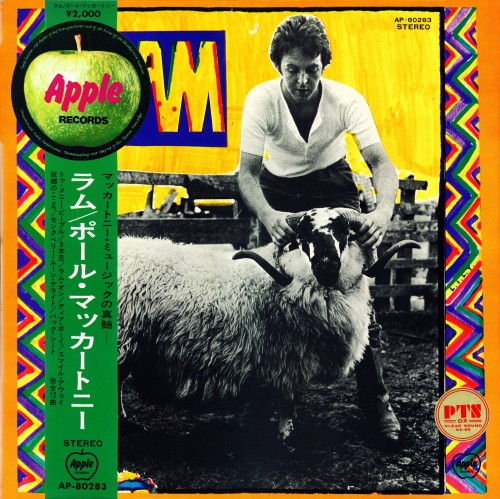

Paul McCartney
“Ram”
1971
Japanese Apple PTS DX Clear Sound pressing, AP-80283
16-bit audio for CD-R
From wikipedia:
After the release of the successful debut McCartney, Paul and Linda went on a lengthy holiday and spent
much time on their farm on the Mull of Kintyre, Scotland. It was during this period that Paul, often with
Linda's input, composed the songs that would feature on Ram. The couple flew to New York City in the fall
of 1970 to record their new songs. Lacking a working band, they held auditions for musicians, bringing
some in under the guise of a session to record a commercial jingle. Denny Seiwell was recruited for drums,
David Spinozza and Hugh McCracken were tapped for guitar duties, and Marvin Stamm was featured on
flugelhorn on "Uncle Albert/Admiral Halsey". Although it was a collaborative project, Linda's vocal duties
were mostly limited to backing Paul, who sang most lead vocals. Linda sang co-lead vocals on "Long Haired
Lady", however. The sessions also birthed future songs like "Dear Friend," released on the debut Wings
album Wild Life later in 1971, as well as "Get on the Right Thing" and "Little Lamb Dragonfly", both of
which would be finished for 1973's Red Rose Speedway.
Despite the phase-out of monaural albums by the late 1960s, Ram was pressed in mono (MAS 3375) with unique
mixes which differ from the common stereo album (SMAS 3375). These were only made available to radio
stations and are among the most valuable and sought-after of Paul McCartney's solo records.
According to Peter Brown, John Lennon believed that songs on Ram included jibes at him in the lyrics,
including "Too Many People" and "Dear Boy". Brown also described the picture of two beetles copulating on
the back cover as a description of how McCartney felt the other Beatles were treating him. McCartney later
said that only two lines in "Too Many People" were directed at Lennon. "In one song, I wrote, 'Too many
people preaching practices,' I think is the line. I mean, that was a little dig at John and Yoko. There
wasn't anything else on [Ram] that was about them. Oh, there was 'You took your lucky break and broke it
in two.'"
Lennon's response was the song "How Do You Sleep?" on his Imagine album. Early editions of Imagine included
a postcard of Lennon pulling the ears of a pig in a parody of Ram's cover photograph of McCartney holding
a ram by the horns.
The album reached #1 in the UK and #2 in the US, where it spent over five months in the Top 10 and went
platinum. The album has sold over two million copies.
At the time of its release, the album was given a mixed critical reception, and Paul was particularly stung
by some of the harsher reviews. Jon Landau in Rolling Stone labeled it "incredibly inconsequential" and
"monumentally irrelevant", while Playboy opined, "you keep wondering why he bothers." However, after the
passage of several years, critics began favorably revising their earlier opinions. By the 1980s, for instance,
Rolling Stone began hailing the album as one of McCartney's best, and retroactively awarded it four (of five)
stars.
Tracks included are:
1. "Too Many People" 4:10
2. "3 Legs" 2:46
3. "Ram On" 2:29
4. "Dear Boy" 2:14
5. "Uncle Albert/Admiral Halsey" 4:53
6. "Smile Away" 3:52
7. "Heart of the Country" 2:24
8. "Monkberry Moon Delight" 5:24
9. "Eat at Home" 3:22
10. "Long Haired Lady" 6:02
11. "Ram On" 0:55
12. "The Back Seat of My Car" 4:28
Bonus Tracks:
13. Too Many People (from a mono promo 45rpm) 4:14
14. Uncle Albert/Admiral Halsey (from a mono promo 45rpm) 4:52
Both of these bonus tracks feature the same dedicated mono mixes that are found on the rare mono promo LP though I expect the mastering is a little different. In comparing these tracks to the needledrops of the mono promo LP I find there’s more bottom-end to the tracks on the mono LP.
The setup used:
-Technics SL-1900 direct drive turntable running an Ortofon 2M Black cartridge
-Underwood/Parts Connexion performance-modified PS Audio GCPH phono preamp
-E-MU 1212M sound card
The audio was captured at 192/32-bit (float)
All pops & clicks were removed manually in Audition. No EQ or NR has been added.
Sample rate conversion to 96kHz & 44.1kHz and down-converting to 16-bit audio was accomplished via iZotope RX Advanced.
Artwork is included for those who care for it.
Enjoy,
-DLedin